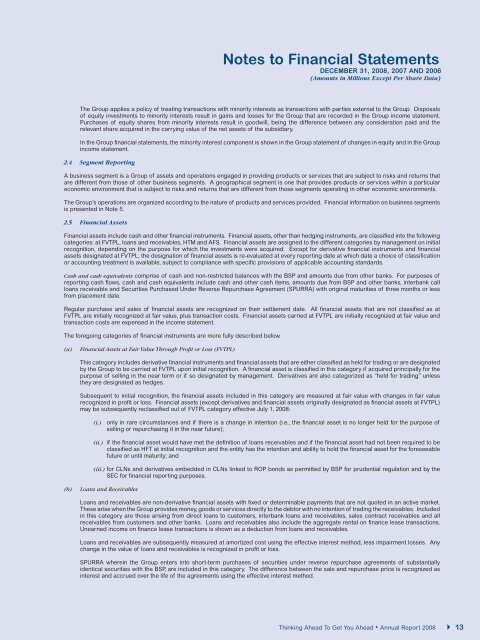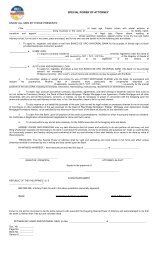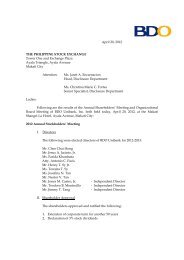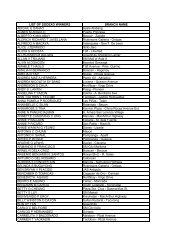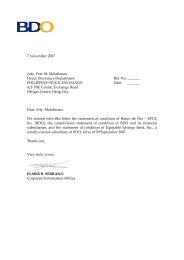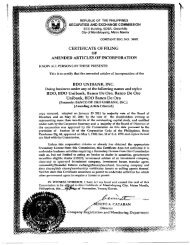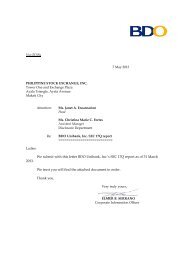Notes to Financial Statements - BDO
Notes to Financial Statements - BDO
Notes to Financial Statements - BDO
You also want an ePaper? Increase the reach of your titles
YUMPU automatically turns print PDFs into web optimized ePapers that Google loves.
<strong>Notes</strong> <strong>to</strong> <strong>Financial</strong> <strong>Statements</strong>DECEMBER 31, 2008, 2007 AND 2006(Amounts in Millions Except Per Share Data)The Group applies a policy of treating transactions with minority interests as transactions with parties external <strong>to</strong> the Group. Disposalsof equity investments <strong>to</strong> minority interests result in gains and losses for the Group that are recorded in the Group income statement.Purchases of equity shares from minority interests result in goodwill, being the difference between any consideration paid and therelevant share acquired in the carrying value of the net assets of the subsidiary.In the Group financial statements, the minority interest component is shown in the Group statement of changes in equity and in the Groupincome statement.2.4 Segment ReportingA business segment is a Group of assets and operations engaged in providing products or services that are subject <strong>to</strong> risks and returns thatare different from those of other business segments. A geographical segment is one that provides products or services within a particulareconomic environment that is subject <strong>to</strong> risks and returns that are different from those segments operating in other economic environments.The Group’s operations are organized according <strong>to</strong> the nature of products and services provided. <strong>Financial</strong> information on business segmentsis presented in Note 5.2.5 <strong>Financial</strong> Assets<strong>Financial</strong> assets include cash and other financial instruments. <strong>Financial</strong> assets, other than hedging instruments, are classified in<strong>to</strong> the followingcategories: at FVTPL, loans and receivables, HTM and AFS. <strong>Financial</strong> assets are assigned <strong>to</strong> the different categories by management on initialrecognition, depending on the purpose for which the investments were acquired. Except for derivative financial instruments and financialassets designated at FVTPL, the designation of financial assets is re-evaluated at every reporting date at which date a choice of classificationor accounting treatment is available, subject <strong>to</strong> compliance with specific provisions of applicable accounting standards.Cash and cash equivalents comprise of cash and non-restricted balances with the BSP and amounts due from other banks. For purposes ofreporting cash flows, cash and cash equivalents include cash and other cash items, amounts due from BSP and other banks, interbank callloans receivable and Securities Purchased Under Reverse Repurchase Agreement (SPURRA) with original maturities of three months or lessfrom placement date.Regular purchase and sales of financial assets are recognized on their settlement date. All financial assets that are not classified as atFVTPL are initially recognized at fair value, plus transaction costs. <strong>Financial</strong> assets carried at FVTPL are initially recognized at fair value andtransaction costs are expensed in the income statement.The foregoing categories of financial instruments are more fully described below.(a)<strong>Financial</strong> Assets at Fair Value Through Profit or Loss (FVTPL)This category includes derivative financial instruments and financial assets that are either classified as held for trading or are designatedby the Group <strong>to</strong> be carried at FVTPL upon initial recognition. A financial asset is classified in this category if acquired principally for thepurpose of selling in the near term or if so designated by management. Derivatives are also categorized as “held for trading” unlessthey are designated as hedges.Subsequent <strong>to</strong> initial recognition, the financial assets included in this category are measured at fair value with changes in fair valuerecognized in profit or loss. <strong>Financial</strong> assets (except derivatives and financial assets originally designated as financial assets at FVTPL)may be subsequently reclassified out of FVTPL category effective July 1, 2008:(i.) only in rare circumstances and if there is a change in intention (i.e., the financial asset is no longer held for the purpose ofselling or repurchasing it in the near future);(ii.) if the financial asset would have met the definition of loans receivables and if the financial asset had not been required <strong>to</strong> beclassified as HFT at initial recognition and the entity has the intention and ability <strong>to</strong> hold the financial asset for the foreseeablefuture or until maturity; and(iii.) for CLNs and derivatives embedded in CLNs linked <strong>to</strong> ROP bonds as permitted by BSP for prudential regulation and by theSEC for financial reporting purposes.(b)Loans and ReceivablesLoans and receivables are non-derivative financial assets with fixed or determinable payments that are not quoted in an active market.These arise when the Group provides money, goods or services directly <strong>to</strong> the deb<strong>to</strong>r with no intention of trading the receivables. Includedin this category are those arising from direct loans <strong>to</strong> cus<strong>to</strong>mers, interbank loans and receivables, sales contract receivables and allreceivables from cus<strong>to</strong>mers and other banks. Loans and receivables also include the aggregate rental on finance lease transactions.Unearned income on finance lease transactions is shown as a deduction from loans and receivables.Loans and receivables are subsequently measured at amortized cost using the effective interest method, less impairment losses. Anychange in the value of loans and receivables is recognized in profit or loss.SPURRA wherein the Group enters in<strong>to</strong> short-term purchases of securities under reverse repurchase agreements of substantiallyidentical securities with the BSP, are included in this category. The difference between the sale and repurchase price is recognized asinterest and accrued over the life of the agreements using the effective interest method.Thinking Ahead To Get You Ahead • Annual Report 2008 13


